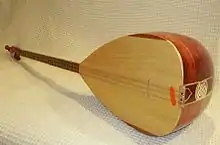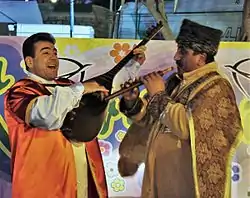Bağlama
The bağlama or saz is a family of long-necked plucked string instruments used in Ottoman classical music, Turkish folk music, Turkish Arabesque music, Azerbaijani music, Kurdish music, Armenian music and in parts of Syria, Iraq, and the Balkan countries.[1]
 Cura (left) and bağlama | |
| String instrument | |
|---|---|
| Classification |
|
| Hornbostel–Sachs classification | 321.321 |
| Related instruments | |
| Sound sample | |
The name bağlama, pronounced [baːɫaˈma], derives from the Turkish verb bağlamak, "to tie". Saz (Persian: ساز) means "to make; to compose" in Persian. It is pronounced [sāz]. According to The New Grove Dictionary of Music and Musicians, "the terms 'bağlama' and 'saz' are used somewhat interchangeably in Turkey."[2] Like the Western lute and the Middle-Eastern oud, it has a deep round back, but a much longer neck. It can be played with a plectrum or with a fingerpicking style known as şelpe.
In Greek music, baglamas (Greek: μπαγλαμάς) refers to a treble bouzouki, a related instrument. The Turkish settlement of Anatolia from the late eleventh century onward saw the introduction of a two-string Turkmen dutar, which has survived in areas of Turkey into recent times.
Turkish bağlama
The most commonly used string folk instrument in Turkey, the bağlama has seven strings divided into courses of two, two and three from top to bottom. It can be tuned in various ways and takes different names according to region and size: Divan sazı, bozuk, çöğür, kopuz, ırızva, cura, tambura, etc. The cura is the smallest member of the bağlama family: larger than the cura is the tambura, tuned an octave lower. The Divan sazı, the largest instrument in the family, is tuned one octave lower still.
A bağlama has three main parts: the bowl (called tekne), made from mulberry wood or juniper, beech, spruce or walnut, the spruce sound board (göğüs) and a neck of beech or juniper (sap). The tuning pegs are known as burgu (literally screw). Frets are tied to the neck with fishing line, which allows them to be adjusted. The bağlama is usually played with a mızrap or tezene (similar to a guitar pick) made from cherrywood bark or plastic. In some regions, it is played with the fingers in a style known as Şelpe or Şerpe.
The electric bağlama, developed through the collaboration of musicians Orhan Gencebay and Erkin Koray in the late 20th century, can be electrically amplified, and is used mostly for large-scale performances and with audio processing effects.
Azerbaijani saz
The Azerbaijani saz was mainly used by ashiqs (literally lovers). The ashiq tradition combines poetry, storytelling, dance and vocal/instrumental music into a performance art. This art is one of the symbols of Azerbaijani culture and considered an emblem of national identity and the guardian of Azerbaijani language, literature and music. Characterized by the accompaniment of the kopuz, the classical repertoire of Azerbaijani ashiqs includes 200 songs, 150 literary-musical compositions known as dastans, nearly 2,000 poems and numerous stories. Since 2009, the art of Azerbaijani Ashiqs has been inscribed on the Representative List of the Intangible Cultural Heritage of Humanity.
The kopuz and the bağlama

The bağlama is a synthesis of historical musical instruments in Central Asia and pre-Turkish Anatolia. It is partly descended from the Turkic komuz. The kopuz, or komuz, differs from the bağlama in that it has a body covered in leather and two or three strings made of sheep gut, wolf gut, or horsehair. It's fretless and meant to be played with the fingers rather than a plectrum. Bağlama literally translates as "something that is tied up", probably a reference to the tied-on frets. The word itself is first encountered in 18th-century texts, such as French traveler Jean-Benjamin de La Borde's travelogues, who visited the Ottoman Empire and recorded that "the bağlama or tambura is in form exactly like the çöğur, but smaller." The çoğur/çöğür was in many ways a transitional instrument between the komuz and the bağlama, with a body similar in shape to the Georgian panduri.
According to Orientalist historian Joseph von Hammer-Purgstall, metal strings were first used on a type of komuz with a long fingerboard known as the kolca kopuz in 15th-century Anatolia. According to 17th-century Ottoman traveler and writer Evliya Çelebi, the çoğur was first made in the city of Kütahya in western Turkey. To take the strain of the metal strings the leather body was replaced with wood, the fingerboard was lengthened and frets were introduced. Instead of five hair strings there were now twelve metal strings arranged in four groups of three. Today, the cogur is smaller than a medium-size bağlama.
Bağlama (Saz) family
| Name | Freq. (low) | Body Length | Bowl Radius | Neck Length | String Length | Description |
|---|---|---|---|---|---|---|
| Cura | 586 Hz D | 22.5 cm | 13.5 cm | 30 cm | 48 cm | The smallest. |
| Üçtelli saz | Three wire strings, single course. | |||||
| Çöğür saz | The Cogur. | |||||
| Tambura | 293 Hz D | 38 cm | 22.8 cm | 52 cm | 80 cm | See Tanbur. |
| Bağlama | 220 Hz A | 44.5 cm | 24.9 cm | 55 cm | 88 cm | The most common. |
| Bozuk saz | G | See bouzouki. | ||||
| Meydan sazı | 110 Hz A | 52.5 cm | 31.5 cm | 70 cm | 112 cm | |
| Aşik sazı | ||||||
| Divan sazı | 146 Hz D | 49 cm | 29.4 cm | 65 cm | 104 cm | |
| Bas sazı | Bass version. |
Tuning
There are three string groups, or courses, on the bağlama, with strings doubled or tripled. There are a variety of common tunings specific to certain areas of Turkey, known as düzen (literally, "order"). For the bağlama düzeni, commonly accepted to be the standard, the courses are tuned from top to bottom as A-G-D. Other tunings include the kara düzen (C-G-D), misket düzeni (A-D-F#) and müstezat (A-D-F).
Scale

The musical scale of the bağlama differs from that of many western instruments – such as the guitar – in that it features ratios that are close to quarter tones. The traditional ratios for bağlama frets are listed by Yalçın Tura:[3]
- Fret 1: 18/17
- Fret 2: 12/11
- Fret 3: 9/8
- Fret 4: 81/68
- Fret 5: 27/22
- Fret 6: 81/64
- Fret 7: 4/3
- Fret 8: 24/17
- Fret 9: 16/11
- Fret 10: 3/2
- Fret 11: 27/17
- Fret 12: 18/11
- Fret 13: 27/16
- Fret 14: 16/9
- Fret 15: 32/17
- Fret 16: 64/33
- Fret 17: 2/1
However, as confirmed by Okan Öztürk,[4] bağlama luthiers now often set frets using equidistant calculators[5] and tuners based on the 24-tone equal temperament.
Notable performers
.jpg.webp)

- Pir Sultan Abdal
- Köroğlu
- Karacaoğlan
- Dadaloğlu
- Muzaffer Sarısözen
- Muharrem Aslan
- Bedia Akartürk
- Gevheri
- Hilmi Şahballı
- Mahsun Kırmızıgül
- Azer Bülbül
- Hilal Özdemir
- Neşat Aydın
- İbrahim Özer
- Volkan Konak
- Yusuf Hayaloğlu
- Ali Özütemiz
- Erzurumlu Emrah
- Aşık Veysel
- Nida Tüfekçi
- Muharrem Ertaş
- Neşet Ertaş
- Çekiç Ali
- Hacı Taşan
- Osman Öztunç
- Ali Ekber Çiçek
- Ruhi Su
- Onur Akın
- Murat Çobanoğlu
- Şeref Taşlıova
- Yıldıray Çınar
- Orhan Hakalmaz
- Esat Kabaklı
- Mustafa Keser
- Hasret Gültekin
- Ahmet Kaya
- Mahzuni Şerif
- Musa Eroğlu
- Edip Akbayram
- Fatih Kısaparmak
- Kıraç
- Dilber Ay
- Hüseyin Altın
- Uğur Işılak
- İsmail Türüt
- Selda Bağcan
- Erkan Ocaklı
- Mustafa Yıldızdoğan
- Arif Şirin
- Kazım Koyuncu
- Mustafa Topaloğlu
- Nuray Hafiftaş
- Erkin Koray
- Erdal Erzincan
- Ferdi Tayfur
- Ersen ve Dadaşlar
- Erol Parlak
- Orhan Gencebay
- Güler Duman
- Ahmet Koç
- Erkan Oğur
- Arif Sağ
- Muhlis Akarsu
- Nesimi Çimen
- Cahit Berkay
See also

References
- "ATLAS of Plucked Instruments – Middle East". ATLAS of Plucked Instruments. Retrieved February 27, 2013.
- Scheherezade Qassim Hassan; Morris, R. Conway; Baily, John; During, Jean (2001). "Tanbūr". In Sadie, Stanley; Tyrrell, John (eds.). The New Grove Dictionary of Music and Musicians. Vol. xxv (2nd ed.). London: Macmillan. pp. 61–62.
- Yalçın Tura, "Türk Musikisinin Mes'eleleri". İstanbul, Pan Yayıncılık, 1988, ISBN 975-7652-02-4. See page 159.
- Zhudki, Aleh. "O. ÖZTÜRK: FROM SEVENTEEN TO TWENTY-FOUR: INSTRUMENTS OF BAĞLAMA FAMILY AND TRADITIONAL TONE SYSTEM". academia.edu. Retrieved 2 April 2018.
- "Bağlamada Perde Ayarları". www.turkuler.com. Retrieved 2 April 2018.